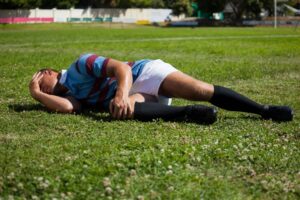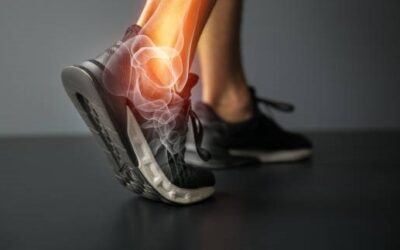Hearing that one of the athletes on your kid’s team suffered an ACL tear is tough. Having to watch your kid tear their ACL can be devastating. And dealing with the uncertainty of when your child can return to play can be scary.
ACL injuries have become so common in sport so we think we know all about it. The concept of “get them evaluated on a Monday, surgery on Thursday, and return to their sport in 6 months” unfortunately seems like the norm amongst parents.
The sad reality is that there can be a bit of a delay in getting in to see the surgeon. Then you have to get an MRI approved with your insurance, as well as getting the MRI scheduled and performed. Finally, you have to set up the surgery and have it performed (if that’s the route you choose). Then the lengthy recovery process begins. This can take a lot of time.
What makes it even worse for parents is seeing their kid struggle with walking and having to use crutches. They also miss time at school, stay in more on the weekends and miss those dances and times with their friends. Most of all, they’re missing out on playing the sport that they love.
An ACL injury can affect the whole family.
Whether their athletic peak is set to be recreational sports or all the way up to being an elite athlete, watching your child miss time because of an injury is devastating. They are missing out on precious and finite times with their teammates and missing out on improving their skills. College coaches or scouts do not have the time to truly assess their skill level.
Not only is this having an impact on the athlete, but it is also tough for the parents to watch this happen to their kids.
That’s why the number one question parents ask me when I am working with their kids on recovering from an ACL injury is: “When will my kid be ready to return to play?”
It is a tough question because there is no definitive timeline. However I will try to give the best guidelines for you, your child, and the healthcare team to use to guide you in the decision.
ACL Stats:
It is estimated that 250,000 athletes suffer from an ACL injury every year. This makes ACL injury one of the most common knee injuries in sports.
What is even more worrisome is that 10% of these injured athletes will go on to suffer another ACL tear.
And, 53% of those who tear their ACL do not return to their sport at a pre-injury level.

How Does an ACL Injury Occur?
The most common way of injuring the ACL is while performing a quick deceleration or acceleration movement with compression through the leg. This occurs through movements like cutting and jumping.
Most ACL injuries, roughly 70%, occur from non-contact. This means these injuries occur from the athlete making the move and not someone knocking into their knee to cause this motion.
The ACL prevents the knee from rotating and the lower leg from pivoting away from the upper leg. Too much rotation or forward/backward movement, especially when there is a lot of compression, can cause an ACL tear.
What is done about an ACL tear?
Typically, especially for those who are playing a sport, there is a surgery to repair the ACL.
I would strongly advise that you take some time and think about this option. Talk it through with your surgeon and rehab professionals. There have been many instances where you can continue to perform at a high level without an ACL. But, it is also critical to get on the same page with your healthcare team and to know what you an your child should expect with either option.
When should an athlete return to play?
The risk of re-tearing your ACL is still very high. It has been estimated that up to 25% of athletes who are younger than 25 will reinjure the ACL on the same leg, or even the opposite leg. Athletes who go back to playing their sport sooner than 9 months after ACL surgery are 7 times more likely to re-injure the same leg.
Sounds scary right?
Well, it gets better. The risk for reinjury significantly drops for those athletes who wait 9 months to return to sport after an ACL tear.
So why is it so hard to adopt an approach to normalizing when an athlete should return?
Because there are significant differences between gender, age, sport played, etc.
Again, this return should be highly specific to your child and be more of a team approach between the healthcare providers, the athlete, and the parents.
Here are the 3 criteria to tell if your athlete is ready to return to play after an ACL tear
1. Has your athlete had enough time to recover from surgery?
Again, this can be a bit variable, but we are all human. We all need time to let the knee recover from such an invasive surgery. In a perfect world, 12 months prior to returning to sport and competition would lower the risk of reinjury significantly.
2. Is you athlete PHYSICALLY ready to return to play after an ACL tear?
This has always been the main focus of any rehabilitation program for returning to sport. Is the athlete physically ready to return to sport? How do you determine that?
There have been a lot of ‘fancy’ tests out there that try to assess readiness through various motions. The thing with those tests is that they are not very specific. Each athlete has a different demand, not just between different sports but also within their own sport.
There is no one movement that is a perfect assessment for everyone.
What is commonly accepted is that the strength of the injured leg should be equal to the strength of the non-injured leg. This can sometime be assessed by using the hamstring-to-quad ratio. This is just the ratio of hamstring strength to quad strength. This should measure at least 80%.
3. Is you athlete MENTALLY ready to return to play?
Your athlete can easily show you that they are physically ready. Our bodies will get stronger the more we work them and that is easy to assess with some simple strength tests.
It is important for you as the parent to realize that your child may not be mentally ready to return to sport. An ACL injury is very traumatic and they are likely going to have some fear and reservations upon return to the sport. Your child has been removed from friends, family, teammates, and their sport in order to rehab their ACL injury.
This can result in poor performance upon return, which can lead to more negative thoughts about the injury, surgery, recovery, and return.
It is important to be aware of their mental readiness to return to play.
Conclusion
Watching your athlete go through an ACL tear is tough. The physical aspect of watching them become less active and the mental aspect of the injury>surgery>recovery>return to sport can be draining for you as well.
There is still no one set standard for returning to sport. But, there are some general guidelines and principles to follow. In addition to the physical guidelines, you also must not forget to take their mental readiness into account.
It is imperative that you also allow for sufficient time for healing and a gradual build up of demand to help your athlete return to the requirements of their sport.
If your athlete has a torn ACL and would like the opportunity to work with ACL rehabilitation specialists, please reach out here for a consultation. We can help whether or not they have opted to have surgery.




